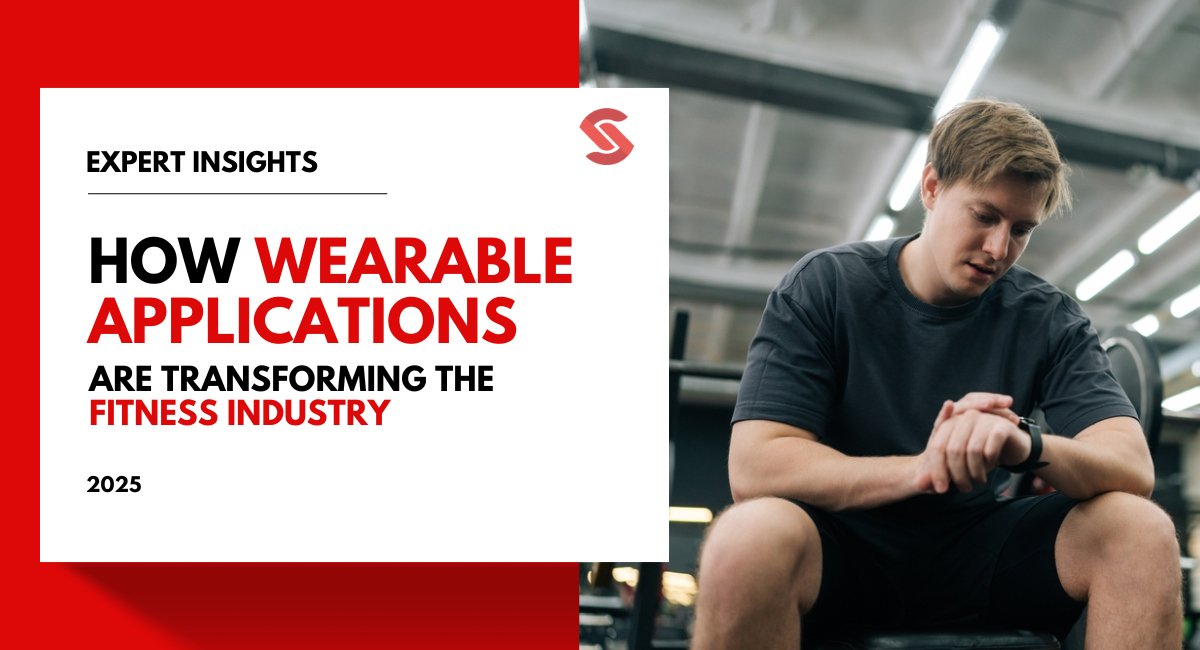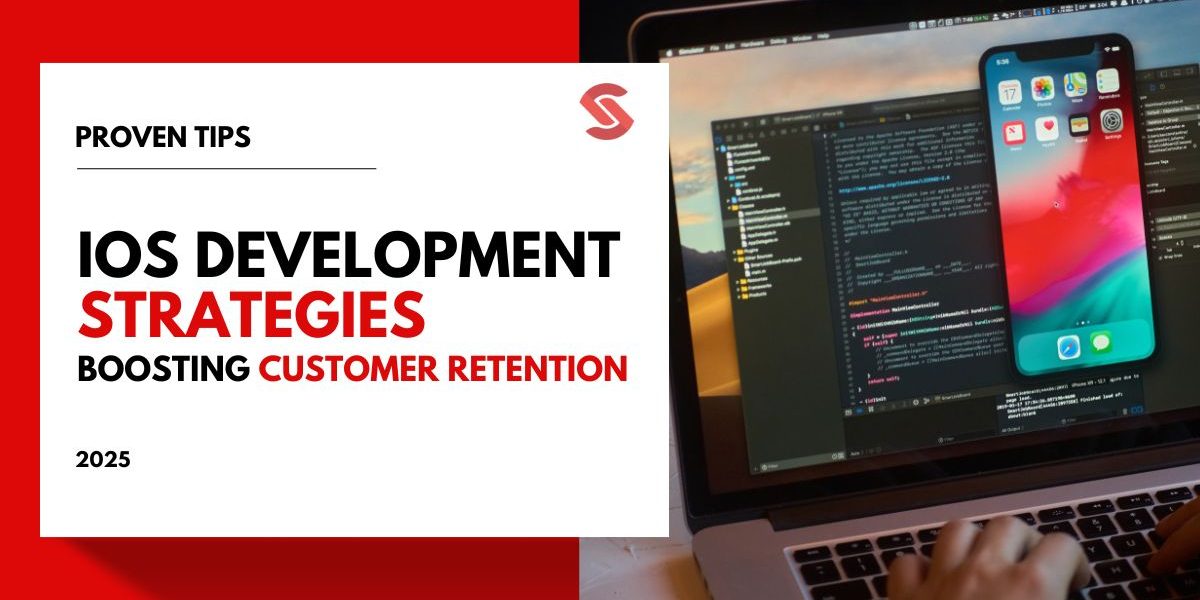Time waits for no one, but with 2025’s wearable fitness apps, keeping track of your health has never been easier. Gone are the days of simple step counters; today’s wearables are true health companions, transforming how we approach exercise, wellness, and daily life. Whether you’re an athlete or new to wellness, wearable apps now act as smart coaches and health advisors.
With AI and advanced sensors, they understand your body’s patterns, offering personalized recommendations that fit your lifestyle. In fact, according to the American College of Sports Medicine in 2025, wearable technology, like sleep-tracking smartwatches and stress-monitoring rings, will top fitness trends, becoming essential tools for modern health and wellness.
In this blog, we will discuss everything from the rise of wearable technology to key features transforming fitness and even the latest technological innovations, so you can examine the exciting trends shaping the future of fitness in 2025.
How Wearable Apps Are Transforming the Fitness Industry in 2025
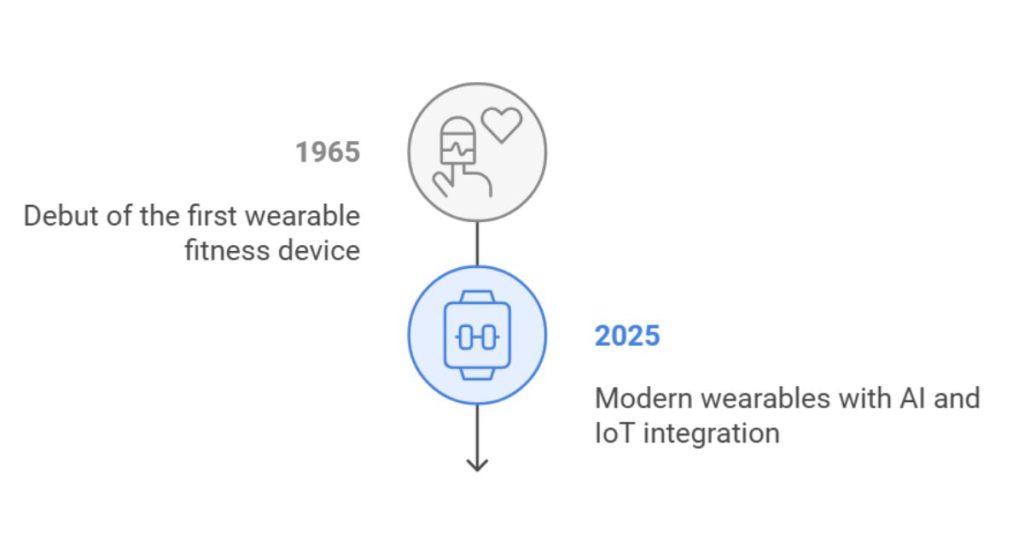
Since the debut of the first wearable fitness device in 1965, wearables have come a long way, and by 2025, they’re more powerful than ever. Modern wearables offer real-time health monitoring, tracking everything from heart rate to sleep patterns.
They create AI-driven, personalized workout plans that adapt as you progress, while IoT integration lets them sync with smart home and gym equipment for a smoother experience.
Engaging users through gamified challenges and in-depth performance analytics, these devices support both physical and mental wellness with hands-free controls, making the fitness journey more enjoyable and accessible.
Advantages and Disadvantages of Wearable Technology
Wearable technology has become an essential component of modern fitness, providing accurate health tracking and new features to improve daily routines. Wearables have changed how we approach health and wellness by tracking important parameters such as heart rate and sleep habits and combining with IoT devices for a seamless user experience. However, despite these advantages, issues such as data privacy, gadget durability, and potential inaccuracies indicate the importance of a balanced awareness of their capabilities.
Advantages of Wearable Technology
- Enhanced Health Monitoring: Wearables enable real-time monitoring of important signs such as heart rate, sleep patterns, and blood oxygen levels, allowing users to make informed health decisions.
- Improved Fitness Tracking: Fitness trackers and smartwatches measure daily steps, calorie burn, and workout progress easily.
- Convenience: Wearables offer hands-free functionality and seamless connectivity with smartphones and IoT devices, making them more convenient for users.
- Motivation through Gamification: Gamification features such as challenges, leaderboards, and awards motivate users to stick to exercise programs .
- Personalized Experiences: Wearables with AI-driven algorithms provide personalized workout plans that adjust to users’ progress.
Disadvantages of Wearable Technology
- Data Privacy Risks: Wearables might compromise sensitive health data to breaches or unauthorized access.
- Battery Limitations: Some devices require regular charging, which might disrupt continuous usage.
- High Costs: Premium wearables are costly, making them unaffordable for some consumers.
- Potential Inaccuracies: Metrics such as calorie tracking and sleep analysis may not sometimes correct.
- Durability Concerns: Wearables can be damaged by water, heat, and physical activity.
Advantages vs Disadvantages of Wearable Technology
| Aspect | Advantages | Disadvantages |
| Social Connectivity | Wearable technology makes it easy to share fitness objectives and accomplishments on social media. | Unhealthy competition or a decrease in confidence may arise from social pressure or comparison.. |
| Behavioral Insights | Wearable technology examines behavior and offers practical recommendations for long-term health advantages. | Excessive use of gadgets can lower self-awareness and feelings of inspiration for fitness. |
| Accessibility Features | Nowadays, a lot of wearables have voice commands and other capabilities for people with disabilities. | Reduced inclusivity for a range of user needs due to limited accessibility in less costly models. |
| Ecosystem Integration | For improved functionality, easily sync with fitness equipment and smart home devices. | Devices that are older or non-standardized might face compatibility problems. |
| Environmental Impact | There is a growing trend toward recyclable materials and eco-friendly designs. | The disposal of outdated, non-sustainable models adds to environmental damage and e-waste. |
with Softnix
Key Features of Wearable Apps Transforming Fitness
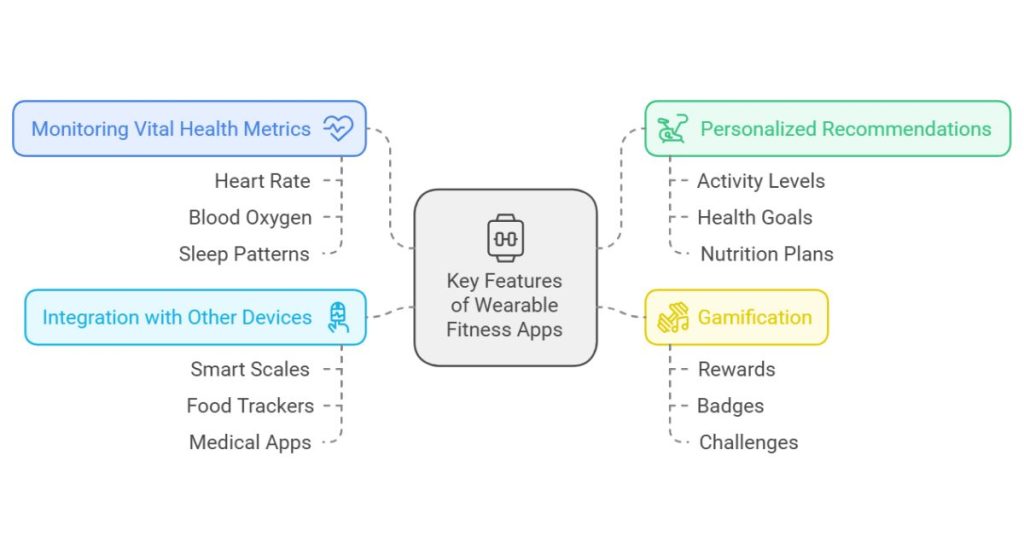
Raising the bar for fitness, these apps combine advanced biometric tracking with AI-driven coaching personalized to each user’s fitness level. Easily connecting with home gyms and equipment, they offer gamified rewards and recovery insights, keeping users motivated and informed throughout their wellness journey.
Social challenges add a fun, competitive element, allowing friends to join in on fitness goals. Hands-free controls, like voice and gesture commands, make these apps easy to use, while strong data security measures ensure that users’ health information remains private and protected.
1. Monitoring Vital Health Metrics in Real Time
Knowledge is power, and fitness apps put it right at users’ fingertips by tracking essential metrics like heart rate, blood oxygen, and sleep patterns in real-time. Equipped with advanced sensors, these devices provide instant data, empowering users to make informed choices for better health.
A research by the American Heart Association shows that regular heart rate monitoring can help detect irregularities early, supporting proactive heart health. Real-time insights offer a clear picture of daily wellness, making it easier to adapt and improve lifestyle habits.
2. Personalized Fitness and Health Recommendations
One size doesn’t fit all, especially when it comes to fitness that’s why wearable apps are redefining personal health by using AI to create individualized fitness recommendations. These apps analyze personal data, like activity levels and health goals, to develop tailored workouts, nutrition plans, and wellness tips.
Every user gets a custom approach that adapts as they progress, making routines both effective and enjoyable. With AI-driven insights, users receive real-time adjustments, ensuring their health plans fit their unique needs for a smarter path to wellness.
3. Gamification and User Engagement
Turning workouts into engaging experiences, fitness apps now use gamification elements like rewards, badges, challenges, and friendly competition. These features boost motivation, encouraging users to stay committed to their fitness goals by making exercise more enjoyable and interactive.
Behavioral scientist Michelle Segar notes that our experience of exercise shapes its meaning; if it doesn’t feel good, it creates a negative association. By adding gamified elements, fitness apps foster positive connections to exercise, encouraging consistent engagement and progress.
4. Integration with Other Health Apps and Devices
Wearable fitness devices are now able to connect seamlessly with other health apps and smart devices, creating a comprehensive view of personal wellness. By syncing with tools like smart scales, food trackers, and medical apps, users can get a holistic look at their health, all in one place. This interconnected health ecosystem helps users stay on track and make informed wellness decisions.
Benefits of Integration with Other Health Apps and Devices:
- Easier Goal Management: Syncing devices helps streamline fitness and health goals.
- Efficient Health Data Sharing: Share metrics easily with healthcare providers, enhancing care.
- Comprehensive Health Tracking: Monitor everything from weight to daily nutrition in one place.
- Enhanced Personal Insights: Cross-platform data provides deeper insights into patterns and habits.
Pros and Cons of Fitness Trackers
The potential of fitness trackers to let users monitor their health metrics and physical activity has resulted in their wide appeal. But even while these gadgets have many benefits, there are limitations that should be taken into account when selecting the best wearable for your fitness objectives.
Pros of Fitness Trackers
- Activity Monitoring Made Simple: Fitness trackers are excellent at recording daily physical activity like heart rate monitoring, calorie expenditure, and step counting. For consumers looking to maintain or raise their fitness levels, these metrics offer insightful information.
- Goal Setting and Motivation: A lot of fitness trackers enable users create customized objectives and provide progress updates and reminders to help them stay motivated. Consistency is increased by features like streaks and milestone celebrations.
- Calorie and Sleep Tracking: Fitness trackers give consumers a more comprehensive picture of their own health by combining sleep analysis and calorie tracking, assisting them in making wise lifestyle decisions.
- Ease of Use: Fitness trackers are a fantastic starting point for users who are unfamiliar with health-focused technology because they are typically less expensive than advanced wearables.
Cons of Fitness Trackers
- Potential Inaccuracy: Despite improvements, fitness trackers may provide inaccurate readings, particularly for measures like sleep phases and caloric burn. This could result in inaccurate health-related conclusions.
- Over-Dependency: People who rely too much on these gadgets may disregard their bodies’ natural signals and feelings regarding their levels of activity or relaxation.
- Limited Features Compared to Advanced Wearables: Although fitness trackers provide essential capabilities, they frequently fall short of premium wearables’ AI-driven insights, sophisticated sensors, and connectivity with medical-grade devices.
- Battery Life Challenges: Users who demand 24-hour tracking may find it frustrating as the majority of fitness trackers require frequent charging.
- Privacy Concerns: Fitness trackers, like other wearable devices, gather confidential data that could be accessed by unauthorized parties.
Fitness Tracker Pros and Cons
| Aspect | Pros | Cons |
| Physical Activity | Efficiently monitors calories, heart rate, and steps. | Distance and calorie burn are two examples of metrics that might not be accurate. |
| Motivation | Provides goal-setting, progress tracking, and gamified rewards. | Device dependence may lower motivational levels. |
| Features | Includes sleep monitoring and basic fitness tracking. | Lacks sophisticated features like tracking of medical grade. |
| Cost | Entry-level alternatives that are affordable for users. | Restricted feature set in contrast to high-end wearables. |
| Privacy | Keeps track of and saves health information for users. | Possible susceptibility to data breaches. |
Technological Innovations in Wearable Fitness Apps
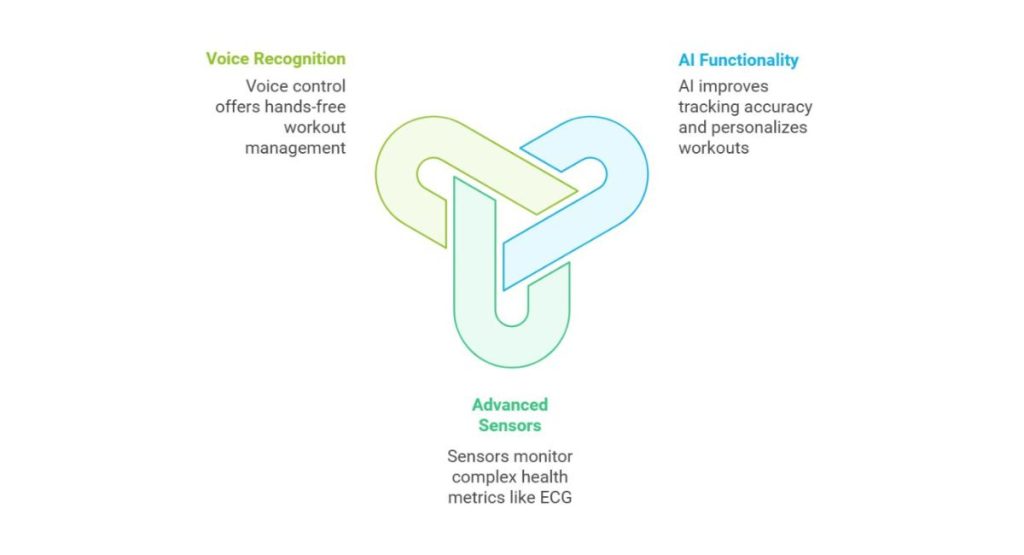
Pushing the envelope in health tracking, fitness apps are now harnessing advanced technologies to make wellness journeys smarter and more engaging. With AI and machine learning delivering personalized insights, and augmented and virtual reality bringing workouts to life, these apps offer immersive guidance that transforms the fitness experience.
Biometric advancements enable precise monitoring of vitals like heart rate and hydration. Real-time feedback, cloud-based data storage, and energy-efficient designs enhance accessibility, creating a seamless, interactive fitness experience that adapts to each user’s needs.
1. How AI Enhances Wearable Functionality
AI is revolutionizing wearables by improving tracking accuracy, personalizing workouts, and providing deep insights into health patterns. Using machine learning, these devices analyze user data to create adaptive workout plans and deliver recommendations that align with individual progress and goals.
With the help of our mobile app development services, we always ensure interfaces such as wearable apps are optimized for intuitive user interactions, making it easy for users to engage with real-time insights. Predictive analytics enable wearables to recognize health patterns and provide proactive tips, making AI-driven fitness tracking more intuitive and effective for users to reach their goals more easily.
2. Advanced Sensors and Biometric Tracking
Wearables are evolving with advanced sensors that monitor complex health metrics like ECG, hydration levels, and even stress indicators, greatly expanding their capabilities. These biometric sensors offer precise health tracking, enabling users to make informed wellness decisions.
For instance, according to the National Institutes of Health, continuous ECG monitoring can help detect early signs of heart abnormalities, making wearables an important tool for proactive health management. With innovations in sensor technology, users can now access a comprehensive view of their health in real-time.
3. Voice Recognition and AI Coaching
Forget pressing the buttons and touchscreens during your workout nowadays, wearable fitness apps are putting the power of voice recognition and AI-powered coaching right at your fingertips. Or rather, your voice. These smart wearables allow you to control your fitness experience entirely hands-free.
Just use simple voice commands to:
- Adjust music, set timers, and log activities without breaking your stride
- Get personalized tips and encouragement tailored to your performance
- Access real-time workout guidance and feedback from your virtual coach
- Seamlessly integrate your wearable with other smart home gym equipment
AI-powered virtual trainers adapt to your fitness level, goals, and habits, offering personalized guidance. They can even adjust workouts in real time, pushing you when they sense you can handle more like having a personal fitness coach with you every step of the way.
Benefits of Wearable Apps in Fitness
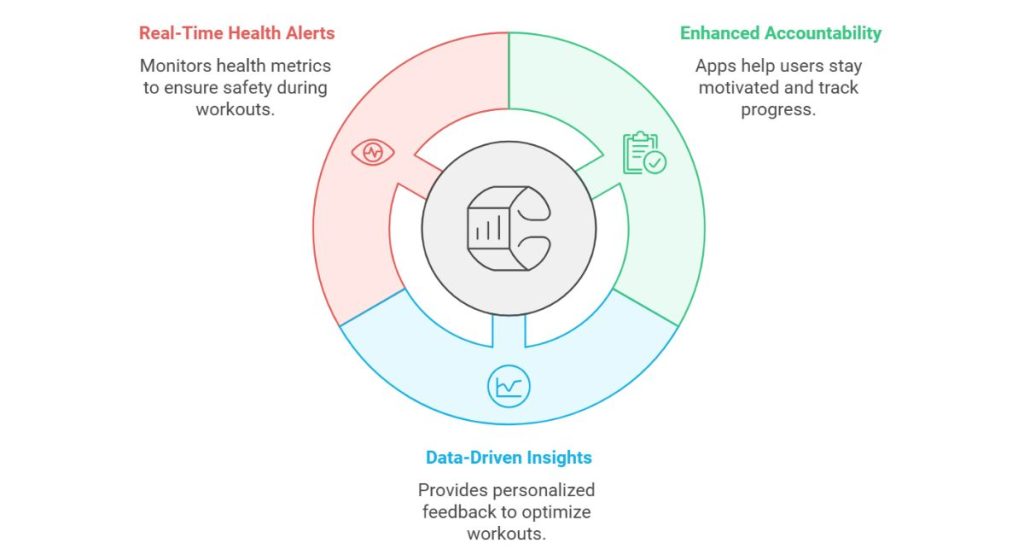
We all have heard that health is wealth, and wearable fitness apps make investing in it easier than ever. These apps offer real-time health monitoring and customized workout plans that keep users on track.
Gamification features like badges and challenges add motivation, while progress tracking helps visualize achievements. With tools to boost workout efficiency, support wellness, and integrate easily with other devices, these apps create a complete and engaging health experience.
1. Enhanced User Accountability and Goal Tracking
Staying on track has never been easier, as fitness apps now help users stay accountable to their goals by tracking progress, setting reminders, and celebrating milestones. Through goal tracking, milestone notifications, and achievement logs, these apps boost motivation, making each step toward wellness a rewarding experience.
Fitness expert Jonathan Goodman emphasizes, “Accountability is the key to long-term fitness success, and wearable technology makes it easier to stay on track.” By consistently logging accomplishments and showing progress over time, these apps provide a clear path to reaching fitness goals, keeping users engaged and motivated.
2. Data-Driven Insights for Improved Performance
Packed with data-driven insights, wearable fitness apps empower users to optimize their workouts. By analyzing real-time biometrics and performance metrics, these apps deliver personalized feedback, ensuring each training session is as effective as possible.
Want to improve your running pace or increase your lifting strength? The data-driven insights from your wearable can pinpoint areas for optimization, suggesting adjustments to your routine that maximize your results. It’s like having a personal fitness coach analyzing your every move to help you achieve your goals.
3. Real-Time Health Alerts and Safety
Enhancing safety, wearable fitness apps monitor vital health metrics and send real-time alerts for potential issues. By notifying users of abnormal heart rates or other warning signs, these apps help prevent injuries and health incidents, making workouts safer and more effective.
According to the American Heart Association, continuous heart rate monitoring can alert users to early signs of cardiovascular stress, allowing them to take precautionary steps. With these proactive health notifications, wearables ensure users stay safe while working toward their fitness goals, adding a crucial layer of security to their routines.
Emerging Trends in Wearable Fitness Apps for 2025
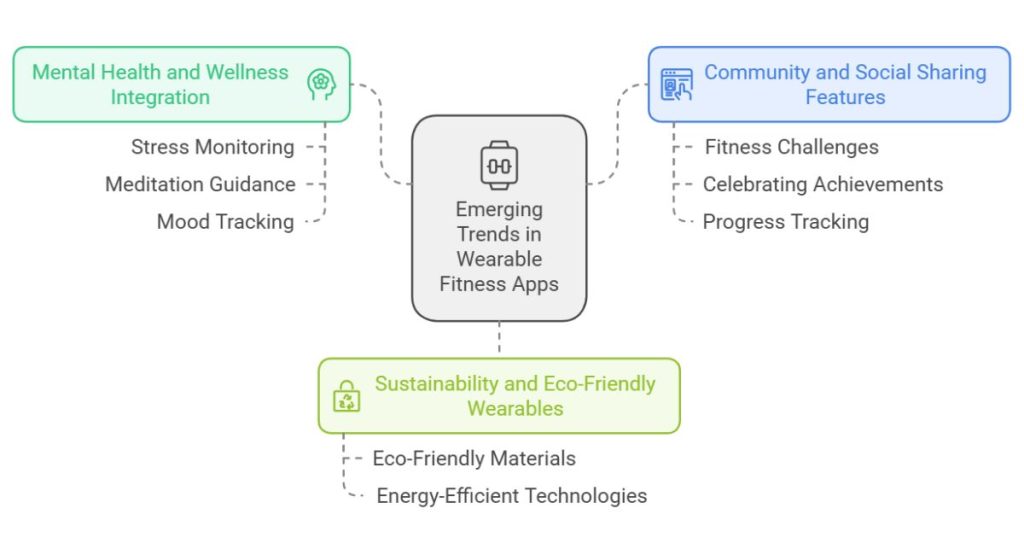
In 2025, wearable fitness apps will reach new heights with AI-driven personalization, smart home fitness integration, and AR/VR-enabled workouts. These advanced apps will not only track physical health but also support mental well-being, utilizing biometric technology to monitor stress and provide a holistic approach to wellness.
Following trends in the app development process helps bring more advanced, cutting-edge products to users. Social challenges boost community engagement, while new voice and gesture controls simplify use. Enhanced data privacy measures ensure sensitive information remains secure, offering a safe, comprehensive fitness experience.
1. Mental Health and Wellness Integration
Wearable fitness apps are expanding beyond physical health to include mental wellness, offering features like stress monitoring, meditation guidance, and mood tracking. These tools support a holistic approach, helping users manage both emotional and physical well-being.
According to a study by the World Health Organization, regularly monitoring stress levels and mood can improve mental health by fostering mindfulness and self-awareness. With personalized recommendations, wearables encourage users to take breaks, meditate, or engage in breathing exercises when stress levels rise.
2. Community and Social Sharing Features
Social sharing and community support are transforming fitness apps, boosting user engagement and motivation. Users can now join fitness challenges, celebrate achievements, and track progress with friends or within a larger fitness community. This sense of belonging empowers users to reach their goals with shared encouragement and accountability.
Benefits of Community and Social Sharing:
- Community Support: Users can find encouragement and advice from like-minded individuals.
- Motivation Boost: Competing with friends or a community encourages users to stay active.
- Friendly Competition: Leaderboards and challenges add a fun, competitive element.
- Achievement Sharing: Sharing progress and wins adds satisfaction and excitement.
By building a community experience, wearable apps make fitness more enjoyable and help users stay committed to their wellness journey.
3. Sustainability and Eco-Friendly Wearables
The fitness industry is increasingly focusing on sustainability, with wearable devices now being made from eco-friendly materials and designed to reduce environmental impact. From renewable materials to energy-efficient technologies, these devices aim to be greener while delivering high-quality performance.
Eco-conscious app development is also on the rise, with apps designed to have minimal energy demands. As sustainability expert Sarah Green notes, “The point of using sustainable products is to reduce our negative impact on the environment, conserve natural resources, promote ethical business practices, and create a more sustainable future for ourselves and future generations.”
Conclusion
Wearable fitness apps have redefined health management with real-time tracking, personalized workouts, and greater user engagement. They help users monitor well-being and stay connected to fitness goals as innovations like advanced biometrics emerge.
AR/VR integration and eco-friendly designs are pushing fitness technology forward. The future of wearable apps looks bright, focusing on data-driven, user-centered experiences. Enhanced privacy and sustainability will make wearables essential for holistic health.
As a trusted wearable app development service provider, Softnix combines expertise with cutting-edge technology to deliver high-impact, user-friendly fitness apps. Softnix’s solutions are tailored to drive engagement, customization, and retention, making them a trusted partner for companies looking to stay ahead in the competitive fitness industry.
Fitness Apps
FAQs about How Wearable App Changing Fitness Industry
What new features are popular in wearable fitness apps?
Popular features in wearable fitness apps include real-time health tracking, AI-powered personalized workouts, AR/VR-enhanced workouts, mental health monitoring, and gamified challenges. Users also enjoy social sharing, stress management tools, and eco-friendly designs, all enhancing their fitness experience in engaging ways.
How accurate are wearable devices in tracking health metrics?
Wearable devices are generally accurate for tracking basic health metrics like steps, heart rate, and sleep. However, accuracy can vary based on the device and activity. Advanced sensors and improved algorithms are continually enhancing precision, especially for metrics like oxygen levels and ECG monitoring.
What’s the role of AI in wearable fitness apps?
AI in wearable fitness apps personalizes workouts, adapts recommendations based on user habits, and provides real-time feedback. It analyzes health data to make personalized suggestions, helping users achieve their goals effectively by optimizing routines, tracking progress, and offering customized insights for health improvement.
How do wearables help improve fitness motivation?
Wearables boost motivation by setting goals, tracking achievements, and offering rewards through gamified challenges. Many devices also provide social features, allowing users to compete with friends or join community challenges, making fitness feel more interactive and encouraging consistent engagement.
Are wearable fitness apps useful for mental health tracking?
Yes, many wearable fitness apps now track stress levels, and sleep quality, and offer mindfulness exercises. By monitoring these aspects, wearables support mental well-being alongside physical health, promoting a holistic approach to wellness with features like mood tracking, guided breathing, and stress management tips.
What sensors are most common in wearable fitness devices?
Common sensors include accelerometers for tracking movement, heart rate monitors, GPS for location, gyroscopes for orientation, and optical sensors for blood oxygen levels. Advanced wearables may also have ECG sensors, temperature sensors, and hydration sensors, offering more comprehensive health insights.
How do wearable fitness apps promote user accountability?
Wearable fitness apps promote accountability by tracking progress, setting reminders, and providing milestone achievements. Users can review their data and see trends over time, keeping them motivated and committed to their goals while also encouraging consistent, healthy habits through regular feedback.
What are the top wearable devices for fitness in 2025?
Top devices in 2025 include smartwatches like the latest Apple Watch, Garmin’s fitness trackers, and the Oura Ring for sleep and wellness tracking. These devices combine advanced health metrics, accuracy, and user-friendly designs, making them favorites for fitness enthusiasts and casual users alike.
How do wearable apps improve user safety during workouts?
Wearable apps improve safety by monitoring vital signs like heart rate and sending alerts if they detect abnormalities. Features like fall detection, emergency alerts, and real-time health warnings help users stay safe, particularly during intense workouts or activities, ensuring prompt responses if needed.
Can wearables integrate with other health apps?
Yes, most wearables sync seamlessly with health apps like Apple Health, Google Fit, and MyFitnessPal. This integration provides a complete view of fitness, nutrition, and health data in one place, making it easier to track progress and share information with healthcare professionals if needed.
How do wearables support personalized fitness programs?
Wearables use data like activity levels, heart rate, and sleep patterns to create customized fitness plans. Through AI, they adapt workouts based on progress, helping users achieve their goals more effectively. This personalization ensures that each routine aligns with the user’s fitness journey.
What is the environmental impact of wearable fitness technology?
The environmental impact includes resource use in manufacturing and battery disposal. However, some brands are moving toward eco-friendly materials and sustainable production methods. Wearables are becoming more environmentally conscious by using renewable materials and energy-efficient designs.
Are wearable apps effective for achieving fitness goals?
Yes, wearable apps can be highly effective in achieving fitness goals. They provide structure, track progress, and offer real-time feedback, helping users stay motivated. Personalized recommendations and data analysis also make it easier for users to adjust routines and see measurable improvements.
How does gamification work in wearable fitness apps?
Gamification in fitness apps includes challenges, rewards, and leaderboards to keep users engaged. Badges, milestones, and competitions add fun to workouts and encourage users to reach goals. This playful approach boosts motivation, making fitness feel more like a game than a chore.
Why is Softnix a top choice for wearable fitness app development?
Softnix excels in wearable app development, offering feature-rich, user-friendly fitness apps that boost engagement and customization. Their expertise in AI, health tracking, and gamification ensures high-quality, innovative apps tailored to client needs, making them a trusted partner in the fitness industry.

